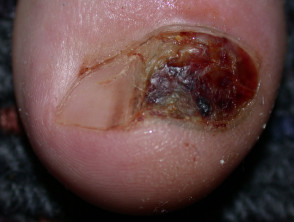DermNet provides Google Translate, a free machine translation service. Note that this may not provide an exact translation in all languages
Quiz
Mixed diagnoses – 10 cases (4 of 11)
For each of the ten cases, study the image(s) and then answer the questions. You can click on the image to view a larger version if required.
Each case should take approximately five minutes to complete. There is a list of suggested further reading material at the end of the quiz.
When you finish the quiz, you can download a certificate.
Case 2
A 23-year-old footballer asks you to look at his great toenail, which has been worrying him for some months. He thinks his boots may have been too tight, and wonders if he's picked up a fungal infection from the changing rooms. You notice that part of the toenail is missing, the residual nail plate is discoloured and the nail bed is ulcerated.
Sign up to the newsletter
© 2024 DermNet.
DermNet does not provide an online consultation service. If you have any concerns with your skin or its treatment, see a dermatologist for advice.
